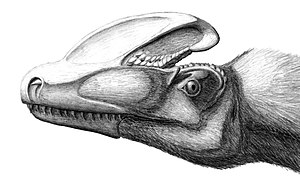Proceratosauridae
| Proceratosauridae | ||||||||||||
|---|---|---|---|---|---|---|---|---|---|---|---|---|

Artistic reconstruction of the skull of Guanlong wucaii |
||||||||||||
| Temporal occurrence | ||||||||||||
| Middle Jurassic to Lower Cretaceous ( Bathonian to early Aptian ) | ||||||||||||
| 168.3 to 123 million years | ||||||||||||
| Locations | ||||||||||||
| Systematics | ||||||||||||
|
||||||||||||
| Scientific name | ||||||||||||
| Proceratosauridae | ||||||||||||
| Rauhut et al. 2010 |
The Proceratosauridae is a family of the Tyrannosauroidea with the type genus Proceratosaurus . They were made by Oliver Rauhut et al. defined as any theropod more closely related to Proceratosaurus than to Tyrannosaurus , Allosaurus , Compsognathus , Coelurus , Ornithomimus, or Deinonychus . This study supports the idea that Proceratosaurus is a tyrannosauroid and the closest relative of the Chinese guanlong . Later studies classify the genera Kileskus and Sinotyrannus .
features
The skulls of the Proceratosauriden were long, low and lightly built and thus resemble those of other coelurosaurs. The intermaxillary bone (premaxilla) was very high, which resulted in a blunt snout - a feature that also developed convergently in the Abelisaurids . The paired nasal bone was fused, slightly arched upwards and mostly very rough, often structured like a bark, on the upper side. The teeth of the intermaxillary bone on the front part of the upper jaw were smaller and differently shaped than the rest of the teeth and had a “D” -shaped cross-section. The lower jaw of all tyrannosauroids except Guanlong had a pronounced crest on the surangular , which extended laterally directly below the temporomandibular joint. Head ornaments were found in the proceratosaurids. In Proceratosaurus a horn is suspected ( Proceratosaurus means something like "pre-horn lizard") and Guanlong a comb has been proven.
The Proceratosauriden had like most other theropods "S" -shaped curved necks and long tails. The genera had three-fingered, long arms that reached 60 percent of the length of the hind legs in Guanlong . Characteristic features in the pelvic bone include a notch of the lower end of the ilium ( ilium ), a clearly limited vertical comb on the ilium, extending from the hip joint socket stretched (acetabulum) upward, and the enlarged end of the pubis ( pubic bone ) with one that extended "T" -shaped on both sides and was more than half as long as the actual shaft of the pubic bone. These features are found in all known tyrannosauroids.
The hind legs of all proceratosaurids, like most theropods, had four toes, although the first toe (the hallux ) did not touch the ground. The hind legs were longer in relation to body size than in almost all other theropods and show proportions that are characteristic of fast-moving animals; thus the shinbone ( os tibia ) and the metatarsal bones were elongated.
Systematics
The Proceratosauridae are counted among the tyrannosauroids , a group that includes Tyrannosaurus . The cladogram shows the relationships:
| Tyrannosauroidea |
|
||||||||||||||||||||||||||||||||||||||||||||||||||||||||||||||||||||||||
|
|
gallery
The bones found from the genus Kileskus
Web links
Individual evidence
- ^ Gregory S. Paul : The Princeton Field Guide To Dinosaurs. Princeton University Press, Princeton NJ 2010, ISBN 978-0-691-13720-9 , pp. 99-100, online
- ↑ Oliver MW Rauhut , Angela C. Milner , Scott Moore-Fay: Cranial osteology and phylogenetic position of the theropod dinosaur Proceratosaurus bradleyi (Woodward, 1910) from the Middle Jurassic of England. In: Zoological Journal of the Linnean Society. Vol. 158, No. 1, 2010, ISSN 0024-4082 , pp. 155-195, doi : 10.1111 / j.1096-3642.2009.00591.x .
- ↑ a b Stephen L. Brusatte, Mark A. Norell , Thomas D. Carr, Gregory M. Erickson, John R. Hutchinson, Amy M. Balanoff, Gabe S. Bever, Jonah N. Choiniere, Peter J. Makovicky , Xing Xu : Tyrannosaur Paleobiology: New Research on Ancient Exemplar Organisms. In: Science . Vol. 329, No. 5998, 2010, pp. 1481-1485, doi : 10.1126 / science.1193304 , PMID 20847260 .
- ↑ a b c Thomas R. Holtz : Tyrannosauroidea. In: David B. Weishampel , Peter Dodson , Halszka Osmólska (eds.): The Dinosauria . 2nd edition. University of California Press, Berkeley CA et al. 2004, ISBN 0-520-24209-2 , pp. 111-136.
- ↑ Xing Xu, Mark A. Norell, Xuewen Kuang, Xiaolin Wang, Qi Zhao, Chengkai Jia: Basal tyrannosauroids from China and evidence for protofeathers in tyrannosauroids. In: Nature . Vol. 431, No. 7009, 2004, pp. 680-684, doi : 10.1038 / nature02855 .
- ↑ a b c Xu Xing, James M. Clark, Catherine A. Forster, Mark A. Norell, Gregory M. Erickson, David A. Eberth, Jia Chengkai, Zhao Qi: A basal tyrannosauroid dinosaur from the Late Jurassic of China. In: Nature . Vol. 439, No. 7077, 2004, pp. 715-718, doi : 10.1038 / nature04511 .



